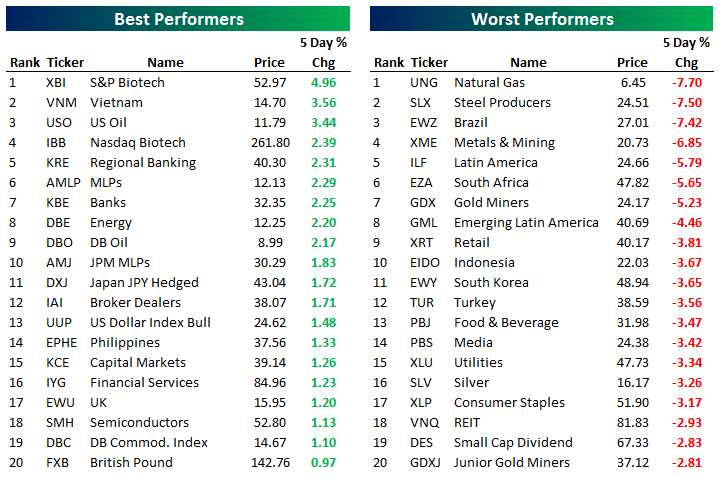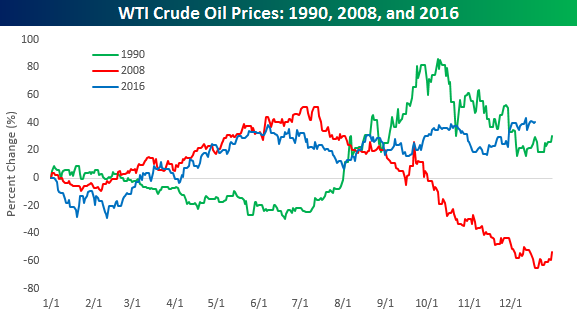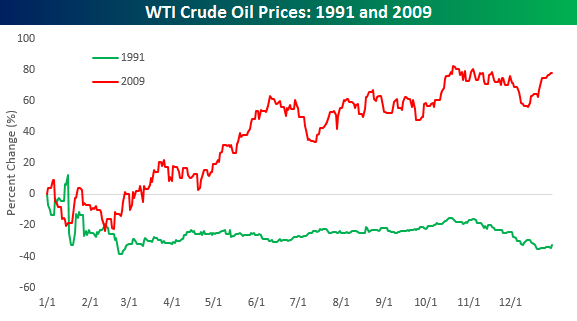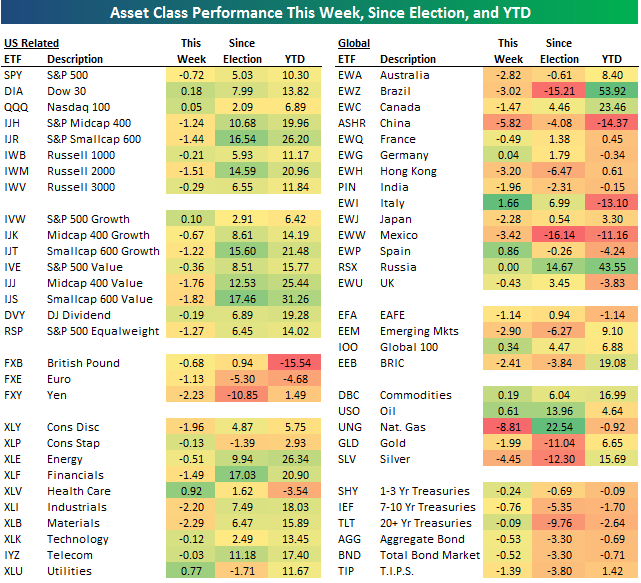Chart of the Day: Sector Correlations
Bespoke Stock Seasonality Report: 12/19/16
ETF Trends: US Sectors & Groups – 12/19/16
Gold miners continue to get absolutely smashed as real rates punish the yellow metal. Steel, metals and mining, China, and Lat Am are also prominent on our list of largest declines among ETFs over the last week. On the bull side of the equation, a strong USD is supporting DXJ and HEDJ while biotech has bounced back a bit. The Nasdaq is the best performer among major US indices in part because of biotech, while Momentum stocks, growth, and micro caps have also done well.
Bespoke provides Bespoke Premium and Bespoke Institutional members with a daily ETF Trends report that highlights proprietary trend and timing scores for more than 200 widely followed ETFs across all asset classes. If you’re an ETF investor, this daily report is perfect. Sign up below to access today’s ETF Trends report.
See Bespoke’s full daily ETF Trends report by starting a no-obligation free trial to our premium research. Click here to sign up with just your name and email address.
Crude Oil’s Wild Ride
Get Bespoke’s 2017 Outlook Report with a 30-day free trial to Bespoke’s premium research! Click here to learn more.
As 2016 winds down and we look back at what transpired over the course of the year, one of the biggest standouts has to be the turnaround in crude oil prices. After starting 2016 just like it finished 2015, crude oil prices were down close to 30% on the year as of early February. However, like the equity market in 2016, crude oil prices staged a major rally and turned big YTD losses into big YTD gains. At current levels, crude is on pace for an annual gain of over 40% and nearly a double from its intra-year low.
Looking back over the last 30+ years of annual returns for crude oil, there have only been two other years where the commodity has been both up 25%+ YTD and down 25%+ YTD in the same year. Those two years were 1990 and 2008. As shown in the chart below, however, both years saw entirely different paths. Like 2016, in 1990 crude oil prices were weak to start the year and then rallied strongly. Obviously, the circumstances were a lot different between now and then as the late year spike in 1990 was driven by Iraq’s invasion of Kuwait. In 2008, the swings occurred in the opposite order where the 25%+ YTD gain occurred ahead of the 25%+ YTD decline.
So what happened after these wildly volatile years for crude oil in the past? Did the commodity start to settle down, or did the volatility continue? The chart below shows the performance of crude oil prices in the year after both of the prior years cited below (1991 and 2009). As shown, the year that followed these two prior years was almost as volatile but in two completely directions. In 1991, oil prices continued the declines they saw in the fourth quarter of 1990 and traded sharply lower in the first quarter of 1991 before settling down for the remainder of the year but still finishing down over 30%. More recently, in 2009 crude oil also started off the year relatively weak before turning around and finishing the year sharply higher with a gain of over 75%. Whichever way it goes next year, one thing you can probably count on with crude oil is that like 2016, the magnitude of the move is likely to be large.
Dynamic Upgrades/Downgrades: 12/19/16
Bespoke Brunch Reads: 12/18/16
Welcome to Bespoke Brunch Reads — a linkfest of the favorite things we read over the past week. The links are mostly market related, but there are some other interesting subjects covered as well. We hope you enjoy the food for thought as a supplement to the research we provide you during the week.
Investing
Superstar Investors (AQR Alternative Thinking)
Quantitative evidence from one of the world’s biggest quant investment firms that there are numerous sources of edge when investing. Notably, however, investors that do not commit to their source of outperformance will likely see performance slide in the longer-term. [Link; 13 page PDF]
Put Forecasting in Its Final Resting Place by Barry Ritholtz (Bloomberg)
An argument against forecasting, which is much easier to get wrong than right. [Link]
Anxious Mutual-Fund Industry Holds ‘Seismic Shift Senior Leadership Forum’ by Sarah Krouse (WSJ)
With assets under management cratering (thanks to the draw of lower-cost ETFs), the strategic challenge for the mostly-active management of mutual funds is: what next? [Link; paywall]
Trade, Jobs, and Profits
Why Doesn’t Apple Export More Services (Wonky) by Brad Setser (Council on Foreign Relations)
We regularly link to Setser’s “look things up and write them down” posts because they’re so informative on obscure topics. This week, he’s looking at how the accounting structure used by Apple and other companies impacts the US balance of payments. [Link]
IBM to hire 25,000 more workers in the US in the next four years and invest $1billion in employee development, tech boss vows ahead of Trump meeting by Hannah Al-Othman (Daily Mail)
Global headcount may have dropped by over 50,000 since the end of 2013 (along with declining revenues) but IBM is still promising big things for US jobs. [Link]
Who Should Be Paying Who
Who wins and loses from America’s transfer union? by Matthew C. Klein (FT Alphaville)
Some states pay higher taxes to the federal government than others; some states also receive more federal spending. The states paying the most relative to what they get back may surprise you. [Link; registration required]
The Case Against Globalisation Reparations by Tomas Hirst (Piera View)
An argument that the solution to political – and social – upheaval brought about by the decline in manufacturing is not some sort of reparation payment. [Link]
Trump Transition
‘Is a Tweet policy?’ State Department officials ponder by Arshad Mohammed (Reuters)
A detailed consideration of the confusion around Trump’s penchant for tweeting major departures from US policy tradition; are those tweets effectively instructions to be followed by diplomats on the ground? [Link]
Republicans face corporate tax rebellion by Barney Jopson (FT)
Massive changes to the US corporate tax code are being considered by Congress, including a so-called “border-adjusted tax” that could bankrupt major retailers by taxing them at greater levels than profit margins. [Link; paywall]
House GOP to Press Ahead With Business-Tax Plan Criticized by Importers by Richard Rubin (WSJ)
Another view on plans to introduce a border-adjusted tax program in the House. [Link; paywall]
McConnell, Warning of ‘Dangerous’ Debt, Wants Tax Cut Offsets by Steven T. Dennis and Sahil Kapur (Bloomberg)
While markets are intently focused on the benefits of fiscal stimulus and corporate tax cuts, the Senate seems unenthusiastic about increasing the deficit by spending more on infrastructure or reducing revenues with tax cuts. [Link]
The On-Demand Economy
Silicon Valley VCs are growing wary of on-demand delivery by Paul Lienert, Heather Somerville and Alexandria Sage (Reuters)
Investment flows into apps that deliver goods or services at the push of a button are flagging, if not outright collapsing. [Link]
Uber Defies California Regulators With Self-Driving Car Service by Mike Issaac (NYT)
Despite orders to either register with the state DMV or halt, Uber continues to operate unauthorized (and possibly illegal) autonomous cars on the streets of San Francisco. [Link; soft paywall]
Consumer Matters
Disgruntled Diesel VW Owners Are Stripping Their Cars Before Turning Them In by David Tracy (Jalopnik)
Thanks to the legalese on buyback terms, VW owners have been given a window to spite the supplier of vehicles that are being bought back under the terms of an EPA settlement. [Link]
How Antibiotic-Tainted Seafood From China Ends Up on Your Table by Jason Gale, Lydia Mulvany, and Monte Reed (Bloomberg)
A horror story about the possible providence of shrimp imported from Southeast Asia, with an overlay of concerning circumstances around antibiotics. [Link]
Economic Research
Partisanship and Economic Behavior: Do Partisan Differences in Economic Forecasts Predict Real Economic Behavior? by Alan S. Gerber and Gregory A. Huber (American Political Science Review)
Not a new piece of research, but this paper from 2009 helps establish that there’s a concrete link between your “side” winning the White House and economic decisions like consumption. [Link; 20 page PDF]
The long-run poverty and gender impacts of mobile money by Tavneet Suri and William Jack (Science)
Provision of mobile banking services has a positive impact on income, wealth, and consumption. [Link]
Foreign Affairs
Canada’s natural resource wealth, 2015 (StatsCan)
Commodity prices are volatile, which makes the annual calculation of the value of Canada’s natural resources…quite amusing. In 2015, the net change was a decline of over 70%. [Link]
China: Renminbi stalls on road to being a global currency by Gabriel Wildau and Tom Mitchell (FT)
A summary of declining metrics of internationalization for the yuan, which had been trending towards a greater role in the global financial system. [Link; paywall]
Clean Energy
GM’s Ready to Lose $9,000 a Pop and Chase the Electric Car Boom by David Welch and John Lippert (Bloomberg)
The size of the Californian auto market means that in order to preserve access a number of firms are enthusiastically selling electric vehicles at a loss. [Link]
Lazard’s Levelized Cost of Energy Analysis Version 10.0 (Lazard)
On an unsubsidized basis, the range of cost per megawatt hour for wind ($32-$62) and solar photovoltaic ($46-$61) has fallen below that of natural gas ($68-$101) or coal ($60-$143). [Link; 22 page PDF]
Potpourri
Beer on tap? Robo barmaid slashes pub waiting time and pours pints with touch of a credit card by Ruki Sayid (Mirror)
A credit card company is the unlikely source of a new way to purchase sudsy goodness. [Link]
She staged a viral story. You fell for her hoax. She thinks that’s beautiful. by Abby Ohlheiser (WaPo)
Some of the most unique and hilarious memes in recent memory (pizza rat, raccoon riding alligator) are hoaxes. [Link; soft paywall]
When a Physicist Asked the FBI to Stop Calling Because He Helped Make the Atomic Bomb by JPat Brown (Atlas Obscura)
When a cold war scientist didn’t like the treatment he was receiving, a sternly worded letter was all that was needed. [Link]
Quick-View Chart Book — 12/17/16
The Bespoke Report – 12/16/16: Holiday Rest?
Before getting to our weekly Bespoke Report and our asset class performance matrix, we want to tell you about our upcoming 2017 Outlook Report. This is our most popular report each year, and it’s a must-read for any serious investor. We have already begun releasing sections of the report this week, and more will be forthcoming next week. If you’re not yet a Bespoke subscriber, you can get Bespoke’s 2017 Outlook Report with a 30-day free trial to Bespoke’s premium research! Click here to learn more.
Below is a look at the recent performance of various asset classes using our key ETF matrix. This matrix is highlighted on page 2 of this week’s Bespoke Report newsletter, which was just sent to Bespoke Premium subscribers. As has been increasingly the case since the election, rather than just mostly winners or losers, this week winners and losers were mixed but this time with a downward bias.
If you’d like to see the rest of this week’s Bespoke Report newsletter, take advantage of our one-month Bespoke Premium free trial offer that includes our 2017 Outlook Report. Sign up now at this page.
Have a great weekend!
The Closer 12/16/16 – End of Week Charts
Looking for deeper insight on global markets and economics? In tonight’s Closer sent to Bespoke clients, we recap weekly price action in major asset classes, update economic surprise index data for major economies, chart the weekly Commitment of Traders report from the CFTC, and provide our normal nightly update on ETF performance, volume and price movers, and the Bespoke Market Timing Model.
The Closer is one of our most popular reports, and you can sign up for a trial below to see it and everything else Bespoke publishes free for the next two weeks!
Click here to start your no-obligation free Bespoke research trial now!
ETF Trends: Hedge – 12/16/16
No ETF we track has gained more than 2% in the past five days. The best performer, Coffee, is bouncing after a long decline off recent highs. Turkey, Italy, and Spain have performed reasonably well, while the USD has outperformed most equities. Energy, European equities hedged against FX moves, and oil have also performed well.
Bespoke provides Bespoke Premium and Bespoke Institutional members with a daily ETF Trends report that highlights proprietary trend and timing scores for more than 200 widely followed ETFs across all asset classes. If you’re an ETF investor, this daily report is perfect. Sign up below to access today’s ETF Trends report.
See Bespoke’s full daily ETF Trends report by starting a no-obligation free trial to our premium research. Click here to sign up with just your name and email address.





